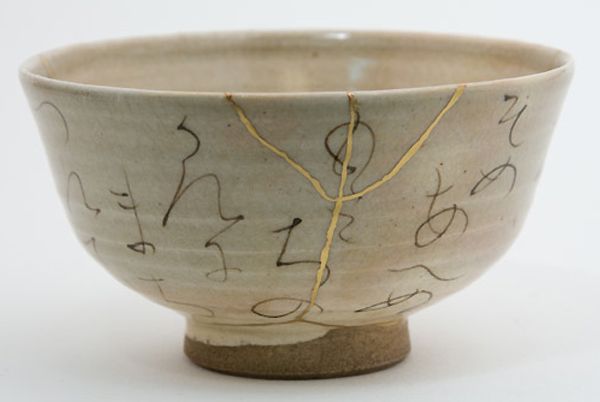In 1847, Margaret Wolfe Hungerford used a phrase in a book that she authored that, in part, has become well used: “…Beauty is in the eye of the beholder.” Perhaps she wasn’t the initial author of the phrase, but she used it in a modern context to explain that what appeals to someone as something beautiful may not always appeal to everybody else in the same way. Most contemporary and post-modern art is, to me, incomprehensible, while others find it profound, penetrating, and, yes, beautiful. Oh, well, different strokes for different folks.
In our most recent Education for Ministry (EfM) class, we used a picture of a cup very similar to the one above. First, we looked at it as an interesting object, determining what it was, what kind of world it would come from, how it was created, and what it meant to the culture that made it. We were off and running.
This teacup started life as a lump of clay, formed by hand, painted, glazed, and fired. It became an everyday, useful cup that could possibly be found in thousands of homes in Japan. Somehow it got broken into pieces. In our culture, it probably would have been thrown out, but in Japan, someone took the time and expense to repair the cup very carefully, using gold resin rather than ordinary glue. Suddenly, the plain broken vessel became something unique and beautiful, a piece of art that was now worth much more than the original unbroken cup had been. It became a treasure, a thing of beauty in the eyes of many beholders.
In our Theological Reflection (TR), we moved to the tradition questions as a way of looking at the object slightly differently. Where was the brokenness in the image? What reminded you of redemption or restoration? Where in our Christian tradition (scripture, hymns, lives of saints, stories, etc.) could we recall that might illustrate what this cup could be a reminder?
We thought of someone taking the time and effort to restore the cup, and that brought us to God taking all of us who are broken in various ways, and healing (if not curing) us so that we could continue our lives in God’s service to the world. We reflected on the healing ministries of Jesus, who took strangers, all broken, and healed them, not to prove his legitimacy as the Son of God but as an example of the power of God and God’s love for the broken of the world.
We are taught to hide our flaws and brokenness. It would make us look bad in the eyes of the world if they could see the cracks and fragments of our inner selves as well as our outer ones. Our self-image, our pride, and our image to the world would be harmed if others could see our internal messes. We are taught to use invisible tape to try to repair things like a torn piece of paper, super glue for just about everything, and an internal form of duct tape to patch the inner flaws and brokenness so that we appear to be whole and healthy. God doesn’t bother with invisible patches (or duct tape, which is far from invisible). God uses love and care to fix the broken, and if it is visible, it makes it much more beautiful than the original was.
What is more, God doesn’t wait for us to bring ourselves for healing. We present ourselves to God for our own sake, not for God’s. God forgives us even if we don’t ask, but speaking of our sins and brokenness makes it more real to us and helps to bridge the gap left by whatever it was that we did. God uses the bridge to bring the pieces together, stronger than before, because we had the strength to ask and the wisdom to realize that God’s forgiveness is guaranteed. That’s not just a gold resin, it’s pure gold, and it’s available to us without reservation.
The mended cup may not be used for tea or saki after it has undergone the kintsugi process. Instead, it becomes a work of art, to be displayed singly, not buried in a cupboard, or in a collection of other pieces. Most often, it has a pedestal or tabletop all to itself to prevent anything else from detracting from the object. It is allowed to be studied and appreciated for itself alone, not as a manufactured or cookie-cut piece like thousands of others. Each piece breaks in its own way and is restored to its original shape but with a beautiful pattern of repair that invites reflection and appreciation.
Perhaps we need to see ourselves in terms of kintsugi. God repairs us because of love, just as the artist who restored the cup did, only God does it with so much more than love and resin. Maybe if we thought of ourselves, and others, in that way, we might become closer to the Kingdom of God people we promise to try to be in our baptismal covenant. Perhaps it would be easier to focus on others rather than staring in our own mirror, looking for brokenness to hide and flaws to cover up. Possibly exposing the flaws God has mended would give someone else the strength to seek God’s forgiveness and grace. It’s much more valuable than gold baubles and perfect images, and it is beauty in the eye of the beholder who may just need some beauty in his or her life.
Think about it.
God bless.
Image: Kintsugi Japanese gold repair . From: The Ceramic School.
Linda Ryan is a co-mentor for an Education for Ministry group, an avid reader, lover of Baroque and Renaissance music, and retired. She keeps the blog Jericho’s Daughter. Her domestic fur-kids, Dominic, Gandhi, and Phoebe, keep her company and often quite amused.

